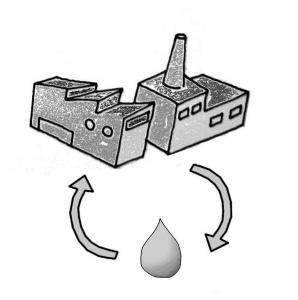Executive Summary
Water re-use options for industry include water cooling towers, reusing process water for washing, industrial fire protection, production line needs, and pH adjustment. Process water can be reused for more purposes if decentralised treatment systems are installed to treat the water to the level required for reuse. This factsheet will discuss both reuse opportunities and treatment options for further reuse.
| In | Out |
|---|---|
Precipitation, Freshwater, Drinking Water, Blackwater,Greywater, Fertigation Water, Treated Water |
Blackwater, Greywater, Fertigation Water, Treated Water, Energy |
Introduction
After agriculture, industry is the largest user of water for development, consuming 5-10% of global water withdrawals (UNESCO 2009). The largest industrial consumers of water are thermal power, iron and steel, paper production, textiles, and petrochemical (GAO et al. 2008).
Reusing water within businesses allows firms to reduce their wastewater discharge to water bodies, reducing the negative impact on surrounding communities and environment. Water reuse can potentially reduce costs in areas where the price of acquiring freshwater is high or water supplies are unreliable. Water can potentially be reused many times, making reuse one of the most significant ways to reduce water consumption. Reducing water consumption also increases the industrial productivity of the product in terms of water used per value of industrial output (GROBICKI 2008).
The cost of adding new pumps, plumbing and treating water for reuse should be compared to the costs of freshwater acquisition (GROBICKI 2008), see also water pricing or water purification. The most common ways to reuse water are for heating and cooling purposes. Reusing process water for internal processes and site irrigation are other options.
Options for Reusing Water in Industries
Cooling towers are one of the most common water technologies in use by industry nowadays. For instance, up to 90% of intake water is used as cooling water in electric power plants or oil refineries. Water is also used in various industries for the generation of steam for manufacturing processes. Cooling water and water from heating is easy to treat, therefore it is easy to reuse. Moreover, rainwater or process water can be used to supplement freshwater for cooling towers and steam generators or boilers. If cooling water cannot be re-circulated, this water can be reused in other processes such as cleaning.
A lot of water is also used in washing processes to remove residues or contaminants from products or manufacturing equipment. Recycling of washing water is also very common but an appropriate treatment system for such a process must be established (see also wastewater treatment).
Process water can be reused for more purposes if decentralised treatment systems are installed to treat the water to the level required for reuse. For process water reuse, internal processes should be re-examined to match water quality to use requirements. Often the water used in industry is high quality, but not all processes require high quality water.
Opportunities for Reusing Process Water
- Transportation of materials
- Air purifiers
- Washing floors
- Sanitary fixtures (toilet flushing, etc.)
- Irrigation
- Running polishing and calibrating equipment
- Process rinse water
- Crate and pallet washing
- Hardstand and vehicle washing
- Industrial fire protection
- pH adjustment
- Dust suppression
- Dying and finishing textiles
Possible treatment options for water reuse include: waste stabilisation ponds, aerated ponds, trickling filters, vertical flow constructed wetlands, hybrid constructed wetlands, free surface constructed wetlands and horizontal flow constructed wetlands.
Treatment options where biogas can be produced using anaerobic digestion: UASB reactors, biogas settlers or large scale anaerobic digesters.
Advanced (more high-tech options): activated sludge, MBRs, advanced oxidation processes, ozonation, activated carbon.
Water reuse can be incorporated into almost any type of industry.
An analysis of industrial water conservation potential and selection of key technologies based on the IWCPA model
The Future of Water Use in Industry. Global Ministerial Forum on Research for Health
This paper gives an overview about the water use in Industry of the past years and makes a projection of future uses. Furthermore, the paper gives advices how to save water in the future.
GROBICKI, A. (n.y): The Future of Water Use in Industry. Global Ministerial Forum on Research for Health. Geneva: World Health Organization URL [Accessed: 06.05.2019]Chapter 7: Evolution of Water Use
Industrial Water Reuse and Wastewater Minimization
This document explains how to reuse water and wastewater in Industry.
MCYINTRE, J.P. (2006): Industrial Water Reuse and Wastewater Minimization. Trevose: GeWater URL [Accessed: 23.07.2010]Water conservation in textile industry
This document explains how you can save water in textile industry. It contains good strategies how to conserve water in different process steps.
SHAIKH, M. A. (2009): Water conservation in textile industry. Karachi: SFDAC URL [Accessed: 09.08.2010]Water Utilisation in African Beverage Industries: Current Practices and Prospects
This document explains how you can save water in beverage industry. It contains good strategies how to conserve water in different process steps.
UNEP (2007): Water Utilisation in African Beverage Industries: Current Practices and Prospects. Nairobi: UNEP, Division of Technology, Industry & Economics URL [Accessed: 06.05.2019]Industrial Water Use
This document illustrates the water use in industry around the world.
SASI GROUP (2006): Industrial Water Use. Sheffield: SASI Group URL [Accessed: 06.05.2019]

